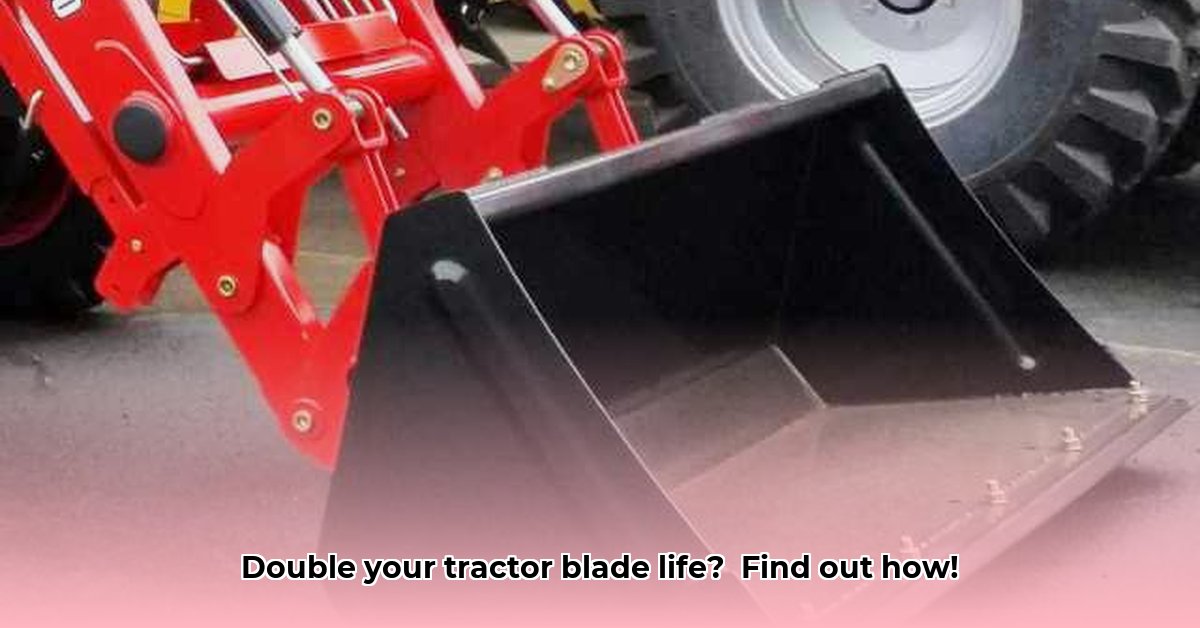
Understanding Reversible Cutting Edges: The Flip-Side Advantage
Reversible cutting edges for your tractor bucket are a simple yet effective way to significantly extend the lifespan of your blades. Unlike traditional single-sided blades, reversible edges feature two sharp cutting surfaces. When one side becomes dull, you simply flip it over, effectively doubling the blade's operational life. This translates directly into cost savings, reduced waste, and a more sustainable farming practice. Isn't that a win-win situation?
For more information on tractor blades, check out this helpful resource.
Did you know that reversible cutting edges can reduce blade replacement costs by up to 50%? This substantial saving can significantly impact your farm's bottom line.
Choosing the Right Reversible Cutting Edge: Matching Blade to Soil
Selecting the appropriate reversible cutting edge is crucial for maximizing its lifespan and effectiveness. Several factors should be considered:
Material Matters: The Steel Behind the Strength
High-carbon manganese steel is a popular choice due to its exceptional durability and wear resistance. However, innovative materials are constantly being explored, promising enhanced performance and reduced environmental impact. Research into eco-friendly alternatives is ongoing and holds potential for future advancements in sustainable agriculture. Staying informed about these developments can help you make even better choices.
What are the advantages and disadvantages of different materials used in reversible cutting edges?
Design Considerations: Tailoring to Terrain
Different blade designs are optimized for specific soil types and applications. A blade ideal for rocky terrains might not be suited for softer soils. Consider your typical farm conditions—rocky, loamy, sandy—when choosing the optimal design. Aggressive cutting angles are more efficient in harder ground. Smoother designs are preferable on easily-worked soil. Consider the trade-offs.
Choosing the right design is crucial. A poorly-matched blade can lead to increased wear and inefficiency. Don’t just go with the first one you see!
Compatibility is Key: Ensuring a Perfect Fit
Before purchasing, always verify compatibility with your specific tractor bucket model and size. An ill-fitting blade is both inefficient and potentially dangerous. Refer to your tractor's owner's manual for precise specifications and compatibility information. This step is vital for safety and performance.
Installation and Maintenance: A Step-by-Step Guide to Longer Blade Life
Installing and maintaining reversible cutting edges is a relatively straightforward process. However, safety must always be prioritized.
Step 1: Prioritize Safety: Engage your tractor's parking brake, shut off the engine, and ensure the area is clear before beginning any work.
Step 2: Removing the Old Blade: Carefully disconnect all securing mechanisms (usually bolts or pins). Keep track of all hardware to avoid issues during reinstallation.
Step 3: Installing the New Blade: Position the new reversible cutting edge accurately within the bucket, ensuring proper alignment and secure seating.
Step 4: Secure Fastening: Tightly fasten all securing mechanisms, preventing any wobble or looseness. Over-tightening can cause damage.
Step 5: Test Run: After installation, conduct a brief test run to verify proper function before resuming regular operations.
Regular inspection is vital. Catch small problems early and prevent bigger issues down the line.
Lifecycle Cost Analysis (LCA): The Long-Term Savings
While the upfront cost of reversible cutting edges might be slightly higher than single-sided blades, the long-term cost savings are substantial. A simple lifecycle cost analysis will illustrate this.
- Initial Investment: Consider the initial purchase price of the reversible cutting edge.
- Replacement Costs: Estimate the number of replacements needed over the lifespan.
- Maintenance Costs: Account for regular maintenance such as sharpening or minor repairs.
- Disposal Costs: Factor in costs associated with responsible disposal of worn blades.
By comparing these factors to the total costs of using single-sided blades over the same timeframe, you can see the significant savings achievable with reversible cutting edges.
Case Studies/Examples (Future Research)
While comprehensive field data is still being collected, anecdotal evidence strongly suggests significant cost savings and increased efficiency through the adoption of reversible cutting edges. Future research will provide more concrete data supporting these benefits. The agricultural community is actively working to collect more data to help you make the best financial and environmental choices.
Conclusion: Sustainable Practices and Smart Spending
Adopting reversible cutting edges is a tangible step towards sustainable and efficient farming practices. By extending blade lifespan, reducing waste, and lowering long-term expenses, you contribute to improved profitability and environmental stewardship. Simple changes can make a big difference!
Key Takeaways:
- Reversible cutting edges significantly extend the lifespan of your tractor bucket blades, compared to standard single-sided blades.
- A careful selection based on material, design, and compatibility is essential for optimal performance.
- A simple lifecycle cost analysis will clearly demonstrate the long-term financial benefits of using reversible cutting edges.
- Implementing reversible cutting edges contributes to more sustainable agricultural practices.